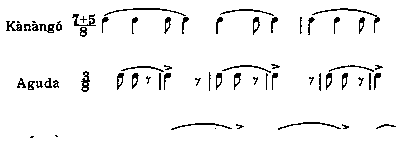Folk & Traditional Music of the Western Continents
The folk & traditional music of Europe, Africa & the Americas explored.
| Share page | Visit Us On FB |
|
I32 AFRICAN MUSIC SOUTH OF THE SAHARA |
||
|
|
||
 |
||
|
|
||
|
Iyallu § PIPMJTP ^ Pl!?(W 7 P
example 7-5. Yoruba drumming in honor of Ogun (god of war). The top part is the smallest and highest drum, the lowest part, the largest and lowest drum. From Anthony King, "Employment of the 'standard pattern7 in Yoruba Music," African Music II, no. 3 (1960), 53.
follow each drum individually. In music using several melodic instruments, or voices and instruments, the structure of the rhythm is as complex as it is in the drumming, and the various voices often perform in different meters. To what extent the performers are listening to each other cannot always be ascertained, and to what degree a listener perceives the total rhythmic structure is also unknown. |
||
|
|
||
|
Polyphony
Closely related to the rhythmic polyphony and to the question of perception of a group of individual rhythmic lines as a unit is the field of polyphony at large, and the question whether in Africa several voices are perceived independently or as a single vertical harmonic structure.
Whether it is polyphony or really harmony, it is very well developed in African Negro music. And it appears in many media. There is choral singing, usually in the responsory form. There is instrumental music of an orchestral nature, with a number of instruments of the same type playing together. And there is something similar to chamber music—instruments of different types playing together, alone or along with singing. Drumming and other percussion may of course act as accompaniment. Finally, there is also the concept of accompanying singing. There is polyphony of many types, and it seems to be present throughout the African Negro area, although it is concentrated in the Eastern cattle area and the Congo or Central Africa. |
||